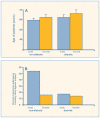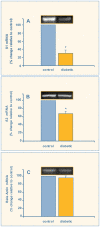Decreased expression of beta1- and beta2-adrenoceptors in human diabetic atrial appendage
- PMID: 12857355
- PMCID: PMC203305
- DOI: 10.1186/1475-2840-2-6
Decreased expression of beta1- and beta2-adrenoceptors in human diabetic atrial appendage
Abstract
Background: Using the streptozotocin-induced diabetic rat model, we have recently showed that the expression and function of beta1-adrenoreceptor were decreased in the diabetic rat heart. However, the effect of diabetes on expression of beta-adrenoreceptors in human cardiac tissue remains undefined. Therefore, the focus of the present study was to investigate the effect of diabetes on mRNA encoding beta1- and beta2-ARs in human atrial tissues.
Methods: Right atrial appendages from five diabetic (mean age 65 +/- 4.5; 4 female, 1 male) and five nondiabetic patients (mean age 56.2 +/- 2.8; 4 male, 1 female) undergoing coronary artery bypass grafting were collected and assayed using reverse transcriptase-polymerase chain reaction (RT-PCR) for their mRNA content. No patient from these two groups suffered from acute myocardial infarction and/or failure. All diabetic patients received insulin for at least two years and had been diagnosed as diabetics for at least five years.
Results: When compared with levels in nondiabetics, steady state levels of mRNA encoding beta1-adrenoreceptor decreased by 69.2 +/- 7.6% in diabetic patients while beta2-adrenoreceptor mRNA decreased by 32.2 +/- 5.5% (p < 0.001).
Conclusions: Our findings show a decreased expression of beta1- and beta2-adrenoreceptors in human diabetic atrial appendage.
Figures



Similar articles
-
Diabetes decreases mRNA levels of calcium-release channels in human atrial appendage.Mol Cell Biochem. 2004 Aug;263(1-2):143-50. Mol Cell Biochem. 2004. PMID: 15524175
-
The effect of diabetes on expression of beta1-, beta2-, and beta3-adrenoreceptors in rat hearts.Diabetes. 2001 Feb;50(2):455-61. doi: 10.2337/diabetes.50.2.455. Diabetes. 2001. PMID: 11272160
-
Diabetes decreases mRNA levels of calcium-release channels in human atrial appendage.Mol Cell Biochem. 2004 Aug;263(1):143-50. doi: 10.1023/B:MCBI.0000041856.92497.0c. Mol Cell Biochem. 2004. PMID: 27520673
-
Effect of rosiglitazone on the expression of cardiac adiponectin receptors and NADPH oxidase in type 2 diabetic rats.Eur J Pharmacol. 2012 Jun 15;685(1-3):116-25. doi: 10.1016/j.ejphar.2012.04.010. Epub 2012 Apr 20. Eur J Pharmacol. 2012. PMID: 22542658
-
The role of cardiac beta1- and beta2-adrenoceptor stimulation in heart failure.J Cardiovasc Pharmacol. 1990;16 Suppl 5:S133-7. J Cardiovasc Pharmacol. 1990. PMID: 11527117 Review.
Cited by
-
Expression and Signaling of β-Adrenoceptor Subtypes in the Diabetic Heart.Cells. 2020 Nov 26;9(12):2548. doi: 10.3390/cells9122548. Cells. 2020. PMID: 33256212 Free PMC article. Review.
-
Exercise training initiated after the onset of diabetes preserves myocardial function: effects on expression of beta-adrenoceptors.J Appl Physiol (1985). 2008 Sep;105(3):907-14. doi: 10.1152/japplphysiol.00103.2008. Epub 2008 Jun 26. J Appl Physiol (1985). 2008. PMID: 18583384 Free PMC article.
-
Lack of miR-133a Decreases Contractility of Diabetic Hearts: A Role for Novel Cross Talk Between Tyrosine Aminotransferase and Tyrosine Hydroxylase.Diabetes. 2016 Oct;65(10):3075-90. doi: 10.2337/db16-0023. Epub 2016 Jul 13. Diabetes. 2016. PMID: 27411382 Free PMC article.
-
The Type 2 Diabetic Heart: Its Role in Exercise Intolerance and the Challenge to Find Effective Exercise Interventions.Sports Med. 2016 Nov;46(11):1605-1617. doi: 10.1007/s40279-016-0542-9. Sports Med. 2016. PMID: 27106558 Review.
-
Association of the beta-1 adrenergic receptor carboxyl terminal variants with left ventricular hypertrophy among diabetic and non-diabetic survivors of acute myocardial infarction.Cardiovasc Diabetol. 2010 Aug 23;9:42. doi: 10.1186/1475-2840-9-42. Cardiovasc Diabetol. 2010. PMID: 20731869 Free PMC article.
References
-
- Rodrigues B, McNeill JH. The diabetic heart: metabolic causes for the development of a cardiomyopathy. Cardiovas Res. 1992;26:913–922. - PubMed
-
- Lefkowitz RJ, Rockman HA, Koch WJ. Catecholamines, cardiac beta-adrenergic receptors, and heart failure. Circulation. 2000;101:1634–7. - PubMed
-
- Fein FS, Aronson RS, Nordin C, Miller-Green B, Sonnenblick EH. Altered myocardial response to ouabain in diabetic rats: mechanics and electro physiology. J Mol Cell Cardiol. 1983;15:769–84. - PubMed
LinkOut - more resources
Full Text Sources

